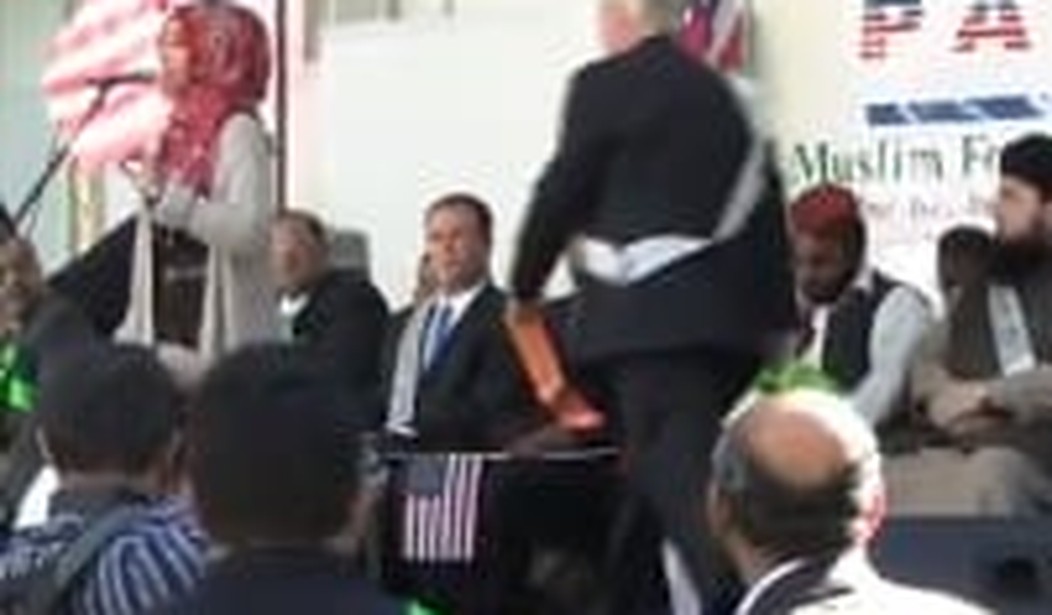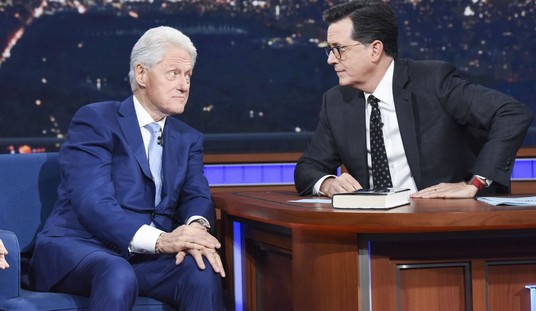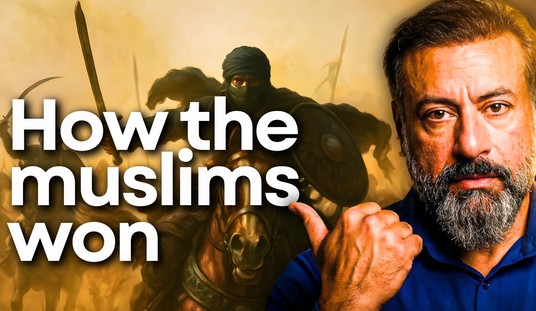The video shows an imam with a thick accent from Brooklyn stating on stage, “The freedom of speak and freedom of rights our problem starts. So, I would like to demand United Nations to make an international law that would criminalize blasphemy.” He reiterates the need for legislation “for the protection of the honor of our beloved prophet.”
Such legislation is one of the foremost causes of Islamists around the world, as it would result in the prosecution and punishment of any perceived attack on Islam, including criticism of the religion or of Islamists that equate criticism of their radical ideology with attacks on all Muslims. This is the call of the Organization of Islamic Cooperation, Mahmoud Ahmadinejad, the Muslim Brotherhood, Turkish Prime Minister Erdogan, and Imam Mohammad Qatanani of the Islamic Center of Passaic County — better known as New Jersey Governor Chris Christie’s “friend,” whom he calls a “force for good” under fire from “bigots.”
The second speaker recited a poem she wrote that stated, “We have the unborn martyrs in our wombs and drop bombs in here because all that we blow up is minds in minefields.” According to Trento, she then condemned the U.S. and called on the ummah (Muslims worldwide) to rise up. The tape further shows her declaring that Palestinians in refugee camps are “housed by Zionist Nazis.” Of course, she didn’t mention the apartheid state in Lebanon that discriminates against Palestinians or the poor treatment they get in other countries.
State Senator Tony Avella, a marshall of the parade, walked off-stage in clear disgust over the comments.
Extremism at the Muslim Day Parade isn’t anything new. The Clarion Fund’s documentary The Third Jihad includes footage of a small group of radicals from the Islamic Thinkers Society and Revolution Muslim preaching about replacing democracy with Shariah law. Dr. Zuhdi Jasser, the Muslim patriot who narrates the film, describes the parade as the “perfect microcosm” of the Muslim-American community. The large majority proudly declare their love for America, but a louder minority is also there.
I was at this same parade featured in the documentary and remember these same speakers justifying attacks on U.S. soldiers overseas and repeating the same kind of extremist themes. I approached an individual who appeared to be one of the parade’s organizers. He stood near a sign for the Islamic Circle of North America, and I asked him to condemn Hamas. He wouldn’t comment.
I also remember watching in horror as some Muslims took literature from the Islamic Thinkers Society, a group that barely hides its extremism. Heading home after the parade, I couldn’t stop worrying about the damage those pamphlets could cause in the future. How many Muslims, especially young ones still trying to determine their views on the world, would be influenced by this rhetoric? Were those pamphlets the seeds for future terrorist attacks?
On the other hand, a colleague with me at the event pointed out that some Muslims glanced at the extremist literature and immediately dropped it or put it back down with an irritated look on their faces. The ideological struggle within the Muslim-American community was on display, though its quiet nature made it only visible to the most interested observers.
The video captured by The United West also demonstrates the dynamics between the largely Islamist leadership of the Muslim-American community, even though the community itself is largely non-Islamist.
At the parade, the Islamists had a position of prominence. They were the ones with the prestige to speak to the audience. These two speakers were leaders. The majority of the parade attendees may not share their extreme views, but there was no audible backlash. No one stood to challenge them.
This happens on a broader level across the country. Groups that originated in the Muslim Brotherhood, like the Council on American-Islamic Relations, the Islamic Society of North America, the North American Islamic Trust, and the Muslim Public Affairs Council, lead the community even if the majority would never support the Muslim Brotherhood or its Palestinian branch, Hamas.
Only 24% of Muslim-American men and 19% of Muslim-American women feel represented by these groups. Almost half of Muslim-American adults oppose mosques getting involved in political matters at all. Yet it’s hard to see any internal challenge to the Brotherhood-linked groups, though that’s changing slowly due to the admirable work of people like Jasser.
Having speakers such as those in The United West’s video spreads Islamist themes and reinforces prejudices that non-Islamist Muslims then have to overcome. It makes the work of anti-Islamist Muslims much harder because it keeps them unseen, tucked away in a corner, looking around for a microphone to use to voice their protests. The Obama administration, government officials, and even some churches are all complicit in embracing the Brotherhood groups as their outreach partners, while groups like the American Islamic Leadership Coalition are left out in the cold.
The episode at this year’s Muslim Day Parade in New York is a reminder of the prominent place Islamists hold in our country.
****
This article was sponsored by the Institute on Religion and Democracy.









Join the conversation as a VIP Member